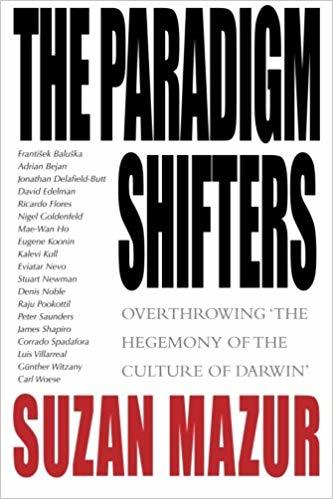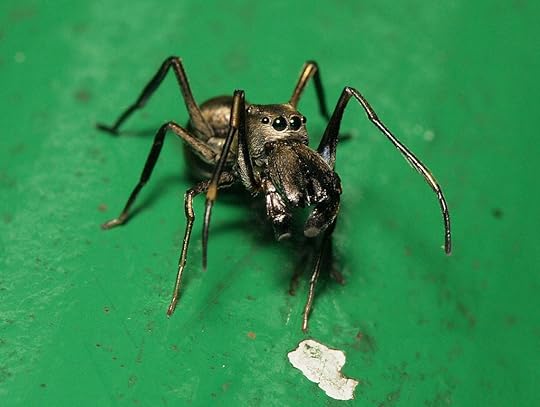Michael J. Behe's Blog, page 562
November 30, 2018
How to falsify reductionism with complex specified information
 A philosopher claims that neuroscience has proven thoughts do not exist. Eric Holloway looks at the neuroscience and examines the claim:
A philosopher claims that neuroscience has proven thoughts do not exist. Eric Holloway looks at the neuroscience and examines the claim:
There is a problem with this sort of reasoning. One could make the same argument about computer code, as follows:
There is no code. It’s all just assembly language.
Or, there is no assembly, it’s all just machine code.
Or, there is no machine code, there are just voltage levels on transistors.
One could continue following this chain of reasoning to the point where the transistors don’t exist. It’s just a bunch of electrons doing their thing.
Of course, the electrons don’t really exist either. They’re just a bunch of quarks and leptons.
In which case, the program your computer requires in order that you can read this article doesn’t exist.
Have we taken a wrong turn somewhere…?
I think we’ve all seen this sort of argument before in many other guises. It is commonly called “reductionism.” The reductionist claims that, because an object can be construed as made up of parts, the object is just the parts. It is like saying that because an article like this one is constructed from letters of the alphabet, the article is only rows of letters and any meaning we get from it is our own subjective interpretation.
Eric Holloway, “Has Neuroscience Disproved Thinking?” at Mind Matters
See also: Human Intelligence as a Halting Oracle Eric Holloway
Does information theory support design in nature? Eric Holloway
and
Do quasars provide evidence for free will? Possibly. They certainly rule out experimenter interference. The universe would seem much neater if everything were determined. One result is that objections to randomness and to free will have become more sophisticated. But have they succeeded?
Copyright © 2018 Uncommon Descent . This Feed is for personal non-commercial use only. If you are not reading this material in your news aggregator, the site you are looking at is guilty of copyright infringement UNLESS EXPLICIT PERMISSION OTHERWISE HAS BEEN GIVEN. Please contact legal@uncommondescent.com so we can take legal action immediately.
Plugin by Taragana
Larry Krauss? Francisco Ayala? And now Neil deGrasse Tyson?
No, they haven’t all come to their senses and seen that of course the frame of reality we live in is designed. No, like Larry Krauss and Francisco Ayala, astronomer and science popularizer Tyson has been #MeToo’d:
Dr. Katelyn N. Allers, Associate Professor of Physics and Astronomy at Bucknell University, told me that she was “felt up” by Tyson at an after-party following a meeting of the American Astronomical Society (AAS) in 2009. AAS didn’t have a mechanism for reporting sexual harassment at the time, but Dr. Allers says she probably would report the incident if it had happened today … David G. McAfee, “Two More Women Accuse Neil deGrasse Tyson of Sexual Misconduct” at Patheos
Readers will remember Tyson from stories like “March for Science: Neil DeGrasse Tyson thinks science denial dismantles democracy,” and “Tyson bombshell: Universe likely just computer sim Twenty-first century, meet your science.” And “Tyson wrong on duck sex. ” Oh yeah, and finding Superman’s home planet, back in the days when something like that wouldn’t provoke a firestorm among the Woke.
Followup: The scout who sent the following, who is hat tipped below, suggests that its hedder should read, “Affirmative-action giant accused of inappropriate sexual conduct”:
How will Science ever survive the downfall and disgrace of Neal DeGrasse Tyson? … It should be amusing to see the academic Left bending over backward to try to Believe All Women while simultaneously defend Black Lives Matter. I guess we’ll see who outranks whom these days in the SJW hierarchy. “The fall of an affirmative action giant” at Vox Popoli
Vox Populi assumes, without offering evidence, that activism today needs to make sense. Not clear.
I (O’Leary for News) am not saying I subscribe to the following theory. I dust it off now and then, as it’s part of my collection of theories bumping around:
Some people think that the #Metoo witch hunt started as an effort to GET someone that nearly 100 percent of Me Too-ers totally hate. Total hatred of whom didn’t seem to do them much good…
Let me unpack this slowly and carefully: As a general rule, if you think that someone you hate is stupid, you should be cautious. You are not an impartial judge. If you have spent a lot of time and energy hating him, that is a measure of the control he has over you, not a measure of the control you have over him.
Just sayin’ is all.
If certain theorists are correct, the #Metoo bomber squad has taken out a whole bunch of guys who weren’t doing much that attracted attention all by itself. They happened to be in the way of the blast. Maybe their places will be taken by more Politically Correct persons. But it is hard to believe that can have been the original goal.
Oh well, who knows? Who reads minds?
 Hat tip: Ken Francis, co-author with Theodore Dalrymple of The Terror of Existence: From Ecclesiastes to Theatre of the Absurd
Hat tip: Ken Francis, co-author with Theodore Dalrymple of The Terror of Existence: From Ecclesiastes to Theatre of the Absurd

News at Linked In
Follow UD News at Twitter!
See also, for some background: Larry Krauss cites physics to fight back against sex harassment charges
At Buzzfeed: Serious sexual assault allegations against celebrity physicist Lawrence Krauss
Francisco Ayala has stepped down in sexual harassment controversy at University of California Irvine
and
AAAS introduces new policy for expelling members which seems to be aimed at seem to be harassment rather than research fraud. Ayala was president of AAAS in 1995.
Copyright © 2018 Uncommon Descent . This Feed is for personal non-commercial use only. If you are not reading this material in your news aggregator, the site you are looking at is guilty of copyright infringement UNLESS EXPLICIT PERMISSION OTHERWISE HAS BEEN GIVEN. Please contact legal@uncommondescent.com so we can take legal action immediately.
Plugin by Taragana
November 29, 2018
Robert Marks Talks Computers with Michael Medved
Robert J. Marks is one of the authors of Introduction to Evolutionary Informatics, with design theorist William Dembski and Winston Ewert.
There’s little danger, he thinks, in computers ruling us but considerable danger that we can use them to magnify the impact of our errors. More.
Here’s the podcast.
See also: Human consciousness may not be computable One model of consciousness would mean that conscious computers are a physical impossibility. (Robert Marks)
Copyright © 2018 Uncommon Descent . This Feed is for personal non-commercial use only. If you are not reading this material in your news aggregator, the site you are looking at is guilty of copyright infringement UNLESS EXPLICIT PERMISSION OTHERWISE HAS BEEN GIVEN. Please contact legal@uncommondescent.com so we can take legal action immediately.
Plugin by Taragana
Darwinism impedes understanding of plant communications
 Plants couldn’t do anything that can’t be explained by the selfish gene, you see:
Plants couldn’t do anything that can’t be explained by the selfish gene, you see:
The sheer complexity of the communications systems plants demonstrate astonishes us to the point that scientists have refused to believe the evidence. In 1983, plant scientists Jack Schultz and Ian Baldwin reported that maple saplings that were exposed to maples damaged by herbivores increased their own defenses. They attributed the increase to the chemical signals released by the injured trees, signals to which the saplings responded.
But, as Cossins recounts, many researchers would not accept that plants could behave so as to benefit neighboring plants but not themselves. Such behavior contradicted evolution theory; it would not be “evolutionarily stable.” However, by 2000, the behavior was demonstrated in a number of species, with the signals being picked up by both members of the sending plant’s own species and by other species as well. “Can Plants Be as Smart as Animals?” at Mind Matters
Follow UD News at Twitter!
See also: Crows Can Be as Smart as Apes But they have quite different brains.
Even Lizards Can Be Smart If you catch them at the right time. But can we give machines what the lizard has by nature?
Is the octopus a “second genesis” of intelligence?
and
Does intelligence depend on a specific type of brain?
Copyright © 2018 Uncommon Descent . This Feed is for personal non-commercial use only. If you are not reading this material in your news aggregator, the site you are looking at is guilty of copyright infringement UNLESS EXPLICIT PERMISSION OTHERWISE HAS BEEN GIVEN. Please contact legal@uncommondescent.com so we can take legal action immediately.
Plugin by Taragana
Biologic Institute’s Brendan Dixon asks, could AI Winter be looming?
 Artificial intelligence crashes are historically common:
Artificial intelligence crashes are historically common:
First, what caused previous AI winters? There was one straightforward reason: The technology did not work. Expert systems weren’t experts. Language translators failed to translate. Even Watson, after winning Jeopardy, failed to provide useful answers in the real-world context of medicine. When technology fails, winters come.
Nearly all of AI’s recent gains have been realized due to massive increases in data and computing power that enable old algorithms to suddenly become useful. For example, researchers first conceived neural networks—the core idea powering much machine learning and AI’s notable advances—in the late 1950s. The worries of an impending winter arise because we’re approaching the limits of what massive data combined with hordes of computers can do. Brendan Dixon, “Is a bad “AI winter” looming?” at Mind Matters
Follow UD News at Twitter!
See also by Brendan Dixon: The “Superintelligent AI” Myth The problem that even the skeptical Deep Learning researcher left out
Copyright © 2018 Uncommon Descent . This Feed is for personal non-commercial use only. If you are not reading this material in your news aggregator, the site you are looking at is guilty of copyright infringement UNLESS EXPLICIT PERMISSION OTHERWISE HAS BEEN GIVEN. Please contact legal@uncommondescent.com so we can take legal action immediately.
Plugin by Taragana
Researchers: Ancient peoples knew their astronomy, some of the oldest cave paintings show

Animal symbols represent constellations, researchers say/Alistair Coombs
From ScienceDaily:
Researchers from the Universities of Edinburgh and Kent studied details of Palaeolithic and Neolithic art featuring animal symbols at sites in Turkey, Spain, France and Germany.
They found all the sites used the same method of date-keeping based on sophisticated astronomy, even though the art was separated in time by tens of thousands of years.
Researchers clarified earlier findings from a study of stone carvings at one of these sites — Gobekli Tepe in modern-day Turkey — which is interpreted as a memorial to a devastating comet strike around 11,000 BC. This strike was thought to have initiated a mini ice-age known as the Younger Dryas period.
They also decoded what is probably the best known ancient artwork — the Lascaux Shaft Scene in France. The work, which features a dying man and several animals, may commemorate another comet strike around 15,200 BC, researchers suggest.
The team confirmed their findings by comparing the age of many examples of cave art — known from chemically dating the paints used — with the positions of stars in ancient times as predicted by sophisticated software.
The world’s oldest sculpture, the Lion-Man of Hohlenstein-Stadel Cave, from 38,000 BC, was also found to conform to this ancient time-keeping system.
This study was published in Athens Journal of History.Paper. (open access) – Martin B. Sweatman, Alistair Coombs. Decoding European Palaeolithic art: Extremely ancient knowledge of precession of the equinoxes. Athens Journal of History, 2018 More.
It’s a bold claim but it’s at least consistent with what we know of ancient peoples of whom we have more detailed knowledge (they took astronomy seriously). Come to think of it, if very ancient peoples had any idea of a comet strike, the idea of the stars “foretelling our future” would make a lot of sense too. Keep the file open.
Follow UD News at Twitter!
See also: Early Human Religion: A 747 Built in the Basement with an X-Acto Knife (Gobekli Tepe)
Is the astronomy in the Book of Job scientifically consistent?
and
New clue in riddle regarding ancient computing machine (the antikythera)
Copyright © 2018 Uncommon Descent . This Feed is for personal non-commercial use only. If you are not reading this material in your news aggregator, the site you are looking at is guilty of copyright infringement UNLESS EXPLICIT PERMISSION OTHERWISE HAS BEEN GIVEN. Please contact legal@uncommondescent.com so we can take legal action immediately.
Plugin by Taragana
Citizen’s panel on the ethics of synthetic cell development urged
At her blog, Oscillations, Suzan Mazur offers suggestions for panelists and explains why more public input is needed in this area, which is ramping up in the United States:
NSF says it cares about the “social and ethical dimensions of such research.” So who gets to say what synthetic cell research meets society’s approval?
I think creating a responsible US citizens panel is urgent.
…
As of now, the NSF plan is to “educate” the American people about synthetic cell development after selections are quietly made by insiders who we don’t know. This approach cannot remain unchallenged. Suzan Mazur, “America Needs a Citizens Panel on Ethics & Synthetic Cell Development” at Oscillations
She notes that Germany is taking a more proactive approach.
The big current controversy around CRISPR babies would seem to answer the question of what happens if we simply wait for events in these areas to overtake us:
He Jiankui, a Chinese scientist who claims he helped to produce the first people born with edited genomes — twin baby girls — appeared today at a gene-editing summit in Hong Kong to explain his experiment. He delivered his talk amid threats of legal action and mounting questions, from the scientific community and beyond, about the ethics of his work.
He had never before presented his work publicly, outside a handful of videos he posted on YouTube. Scientists welcomed the fact that he appeared at all — but his talk left many hungry for more answers, and still not completely certain that He’s claims are accurate.David Cyranoski, “CRISPR-baby scientist fails to satisfy critics” at Nature
At this point, it’s not about whether anyone approves or not, it’s not even clear who besides He Jiankui knows what is going on.
 Suzan Mazur is the author of The Paradigm Shifters: Overthrowing ‘the Hegemony of the Culture of Darwin’ and The Altenberg 16: An exposé of the evolution industry.
Suzan Mazur is the author of The Paradigm Shifters: Overthrowing ‘the Hegemony of the Culture of Darwin’ and The Altenberg 16: An exposé of the evolution industry.
See also: “1st International Symposium on Building a Synthetic Cell,” Netherlands, August 28–29
Suzan Mazur on mechanobiology, the next level of understanding of the cell
Copyright © 2018 Uncommon Descent . This Feed is for personal non-commercial use only. If you are not reading this material in your news aggregator, the site you are looking at is guilty of copyright infringement UNLESS EXPLICIT PERMISSION OTHERWISE HAS BEEN GIVEN. Please contact legal@uncommondescent.com so we can take legal action immediately.
Plugin by Taragana
Move over, mammals. Spiders provide milk for their young too

male Toxeus magnus/Sarefo (CC BY-SA 3.0)
Researchers knew that jumping spider (Toxeus magnus) young didn’t leave the nest for twenty-one days and adults were not observed to bring back food for them. So they checked it out:
They looked more closely and noticed that the mother was secreting a liquid from its upper abdomen onto the surface of the nest, which the spiderlings ate. After a week, the spiderlings sucked the milk directly from the mother. Even though they were able to leave the nest and feed themselves after 20 days, they continued suckling the milk for another 18 days. If these were humans, they’d be featured on a cable TV program. Once the spiderlings matured, the mother attacked the males that returned while females were still allowed in, perhaps to prevent inbreeding, according to the study published today in Science.Ryan F. Mandelbaum, “Spider Mothers Produce Milk for Their Young, Incredible New Study Shows” at GIZMODO
Also:
Abstract: Abstract
Lactation is a mammalian attribute, and the few known nonmammal examples have distinctly different modalities. We document here milk provisioning in a jumping spider, which compares functionally and behaviorally to lactation in mammals. The spiderlings ingest nutritious milk droplets secreted from the mother’s epigastric furrow until the subadult stage. Milk is indispensable for offspring survival in the early stages and complements their foraging in later stages. Maternal care, as for some long-lived vertebrates, continues after the offspring reach maturity. Furthermore, a female-biased adult sex ratio is acquired only when the mother is present. These findings demonstrate that mammal-like milk provisioning and parental care for sexually mature offspring have also evolved in invertebrates, encouraging a reevaluation of their occurrence across the animal kingdom, especially in invertebrates. (paywall) More. Zhanqi Chen1, Richard T. Corlett1, Xiaoguo Jiao2, Sheng-Jie Liu3, Tristan Charles-Dominique1, Shichang Zhang2, Huan Li1, Ren Lai4, Chengbo Long4, Rui-Chang Quan1,* Science 30 Nov 2018: Vol. 362, Issue 6418, pp. 1052-1055 DOI: 10.1126/science.aat3692
Follow UD News at Twitter!
Talk about convergent evolution. Some of the behavior reminds one of a mammalian burrow:
Twenty days after hatching, the spiderlings make their first forays out of the nest, and start hunting for small flies. But they still return to their mother to drink her milk, until finally weaning at 40 days of age. Even then, most of them stay in the nest for many weeks more, while the mother continues to care for them. She’ll throw out their molted exoskeletons, repair the nest, and evict parasites such as mites. Ed Yong, “There’s a Spider That Makes Milk” at The Atlantic
See also: “Live action” captured in a spider’s web from 100 million years ago
Researchers teach a spider to jump on demand
and
Spiders evolving disguises separately, in parallel, are another problem for Darwinism
Copyright © 2018 Uncommon Descent . This Feed is for personal non-commercial use only. If you are not reading this material in your news aggregator, the site you are looking at is guilty of copyright infringement UNLESS EXPLICIT PERMISSION OTHERWISE HAS BEEN GIVEN. Please contact legal@uncommondescent.com so we can take legal action immediately.
Plugin by Taragana
New findings: Discrepant values in universe’s expansion make everything murkier

Big Bang/NASA
Error alone does not apparently explain the discrepancy in these figures:
For some methods, which rely on using the light from supernova and pulsing stars called Cepheid variables to determine their changing distance, it appears that objects move away from the Earth 73 kilometers per second faster for every 3.26 million additional light-years, also called a megaparsec. For other measuring methods, which rely on the electromagnetic radiation that reaches us from the early universe called the cosmic microwave background, the value is around 67 kilometers per second per megaparsec.
…
Most recently, a new result from scientists running the Dark Energy Survey has muddied the waters. Using measurements from supernovae, they in fact measured a Hubble constant of 67.7 kilometers per second per megaparsec, closer to the early universe measurement.Ryan F. Mandelbaum, “‘Expanding Universe Mystery Deepens” at Gizmodo
Amid calls for new physics, two new papers propose two different solutions. It’ll stay interesting, that’s for sure.
Follow UD News at Twitter!
See also: Rob Sheldon on the physics wars: Stagnation or not? Oh sure, more data, there’s always more data. But new? Hardly. That is exactly the sort of stagnation Sabine Hossenfelder is talking about. An entire graduate student lifetime without anything new to report.
Theoretical physicist: My field is not going to the dogs Fair enough. But when you need a press agent, Madam Physicist, you need one. Why are you letting crackpots control the news stream from your field?
Is cosmology in crisis over how to measure the universe? One wonders how much of the problem stems from the need for a different universe from the one we have.
Theoretical physicist: Present phase of physics “not normal” – stagnation, not crisis Sabine Hossenfelder notes that working on the hard mathematical problems led to breakthroughs in physics but fears that, once again, the continued organization of conferences and production of papers will be the choice. Oh, and nonsense: “blathering about naturalness and multiverses and shifting their ‘predictions,’ once again, to the next larger particle collider.”
and
Physicist: The ultimate theory will be “geometrically natural” Garrett Lisi at Sabine Hossenfelder’s blog: “The high energy physics community has spent far too much time following the bandwagon of superstring theory, long after the music has stopped playing. It’s time for theorists to spread out into the vast realm of theoretical possibilities and explore different ideas.” He also thinks that the “naturalness” aesthetic that the fundamental constants should be near 1 is a “red herring” because “the universe doesn’t seem to care about that.” Many will likely welcome the freedom to explore new ideas.
Copyright © 2018 Uncommon Descent . This Feed is for personal non-commercial use only. If you are not reading this material in your news aggregator, the site you are looking at is guilty of copyright infringement UNLESS EXPLICIT PERMISSION OTHERWISE HAS BEEN GIVEN. Please contact legal@uncommondescent.com so we can take legal action immediately.
Plugin by Taragana
November 28, 2018
Rob Sheldon on the physics wars: Stagnation or no?
Our physics color commentator, Rob Sheldon, was looking at two physicists’ recent salvos and offers some thoughts:
Nicole Yunger Halpern (Theoretical physicist: My field is not going to the dogs
vs.
The point of view represented by Sabine Hossenfelder (Theoretical physicist: Present phase of physics “not normal” – stagnation, not crisis) and Sarah Scoles (Is cosmology in crisis over how to measure the universe?)
Halpern’s response is typical. She’s a young, female, postdoc with jobs at MIT and Harvard. Of course, the future looks bright! Now if it had been a white, male, 40-ish, on his third-postdoc at a 2nd tier school, the story would have been very different.
But Halpern is exactly who Sabine Hossenfelder is talking to. What she wrote was:
How long can they go on with this, you ask? How long can they keep on spinning theory-tales?
I am afraid there is nothing that can stop them. They review each other’s papers. They review each other’s grant proposals. And they constantly tell each other that what they are doing is good science. Why should they stop? For them, all is going well. They hold conferences, they publish papers, they discuss their great new ideas. From the inside, it looks like business as usual, just that nothing comes out of it.
This is not a problem that will go away by itself.
What Nicole Halpern says is all true—non-equilibrium stat mech is great progress after stagnation in the equilibrium variety. And these theorems are interesting—even if they don’t result in any new techniques, motors, computers, or Wall Street algorithms. But her very enthusiasm belies her words.
She wants to say it is new. My officemate in grad school, admittedly a far geekier genius than I, had worked out the “power-law” tails of non-equilibrium systems in 1989 under some prodding of my own. The “founding paper” that gives the theory for these results, was published in 1999.
She is a recent graduate, say, 22 years of age. And the work she is so excited about was done before she was born.
Oh sure, more data, there’s always more data. But new? Hardly.
That is exactly the sort of stagnation Sabine Hossenfelder is talking about. An entire graduate student lifetime without anything new to report.
![The Long Ascent: Genesis 1â 11 in Science & Myth, Volume 1 by [Sheldon, Robert]](https://i.gr-assets.com/images/S/compressed.photo.goodreads.com/hostedimages/1541285109i/26543752.jpg) Rob Sheldon is the author of Genesis: The Long Ascent
Rob Sheldon is the author of Genesis: The Long Ascent
Follow UD News at Twitter!
See also: Theoretical physicist: My field is not going to the dogs Fair enough. But when you need a press agent, Madam Physicist, you need one. Why are you letting crackpots control the news stream from your field?
Is cosmology in crisis over how to measure the universe? One wonders how much of the problem stems from the need for a different universe from the one we have.
Theoretical physicist: Present phase of physics “not normal” – stagnation, not crisis Sabine Hossenfelder notes that working on the hard mathematical problems led to breakthroughs in physics but fears that, once again, the continued organization of conferences and production of papers will be the choice. Oh, and nonsense: “blathering about naturalness and multiverses and shifting their ‘predictions,’ once again, to the next larger particle collider.”
and
Physicist: The ultimate theory will be “geometrically natural” Garrett Lisi at Sabine Hossenfelder’s blog: “The high energy physics community has spent far too much time following the bandwagon of superstring theory, long after the music has stopped playing. It’s time for theorists to spread out into the vast realm of theoretical possibilities and explore different ideas.” He also thinks that the “naturalness” aesthetic that the fundamental constants should be near 1 is a “red herring” because “the universe doesn’t seem to care about that.” Many will likely welcome the freedom to explore new ideas.
Copyright © 2018 Uncommon Descent . This Feed is for personal non-commercial use only. If you are not reading this material in your news aggregator, the site you are looking at is guilty of copyright infringement UNLESS EXPLICIT PERMISSION OTHERWISE HAS BEEN GIVEN. Please contact legal@uncommondescent.com so we can take legal action immediately.
Plugin by Taragana
Michael J. Behe's Blog
- Michael J. Behe's profile
- 219 followers



